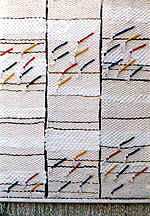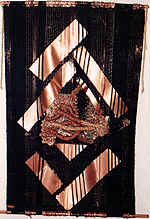|
|
Tapestry appeared in China, India, Egypt and Mesopotamia around 7000 years ago.
In Iran, During Safavid era, art of weaving reached the zenith of beauty and elegance, but since many people and artists preferred to decorate their floors, many colorful woven adorned the floors of Iranian houses and walls left for most parts bare. However, there were many woven curtains (needle-works, brocades,...) used primary to create privacy or partition within the interior space of the house.
During the same period, picturesque fabrics were used as wall hangings, which were mixture of carpets, bearing miniature images. The oldest Iranian example of such works was found in Pazirik area, which is kept in Armitage Museum of Russia.
Tapestry is a weft showing fabric, whose pattern is created through free knots. Wefts cover the selvage creating the design.
Nowadays, Tapestry is defined as fabrics of fine dimension, hung on walls or suspended from the ceiling, to separate the interior space of a room.
The material used in this art are linen, wool, silk and artificial fibers. In addition, such ornamental objects, as wooden or metal beads, are also included in the design.
Tapestry weaving techniques are basically the same as those used to produce carpets (rug, kilim, jajim, gabbeh...), textile, macramé, needle-works and knitting.


|
|


